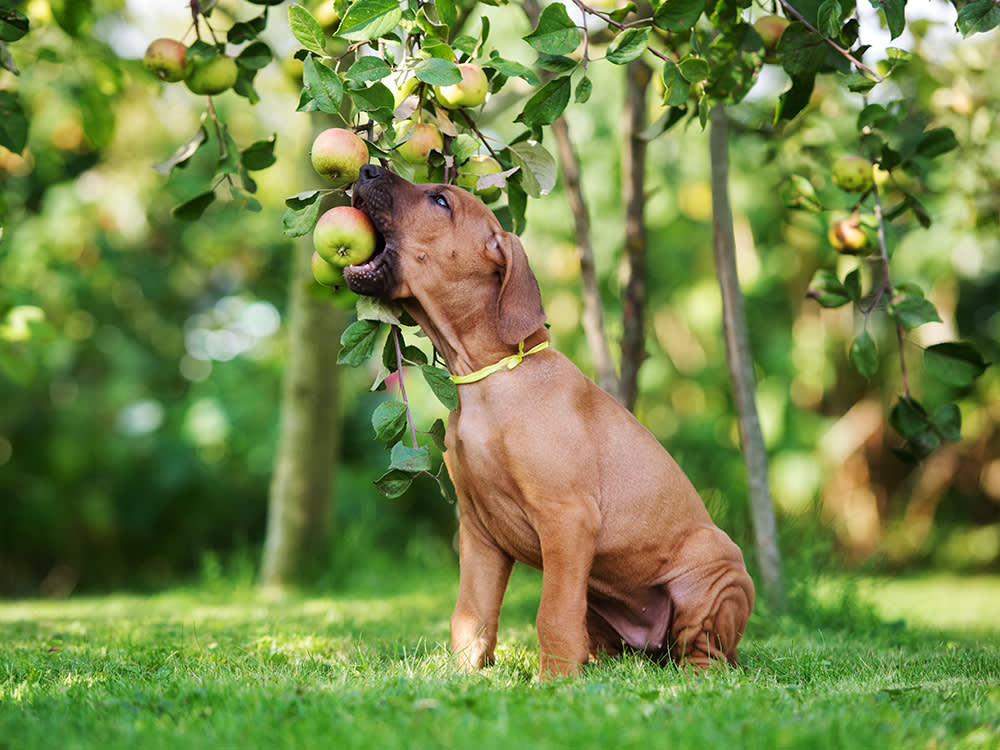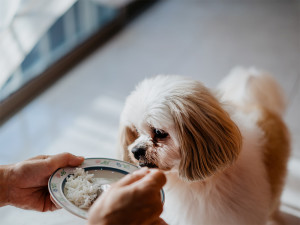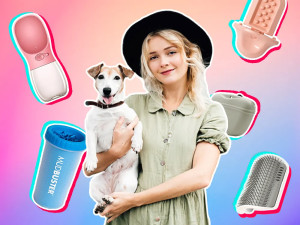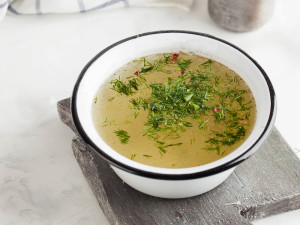Can Dogs Eat Apples?
Yep – this fibre-filled fruit is a healthy treat for your dog

share article
Turns out, the old saying, ‘An apple a day keeps the doctor away’ is true for your dog, too. Apples are safe for dogs to eat – and for many pups, this sweet, crispy fruit is a favourite treat. That’s a good thing since apples are packed with essential vitamins and mineralsopens in a new tab, including vitamins A, C and K, as well as calcium and phosphorus. Many dogs seem to prefer the sweeter varieties – reds or goldens – to the green or more tart types, like Granny Smith. Keep reading to learn more about the health benefits of apples for dogs, plus how to add them to your pup’s diet.
The health benefits of apples for dogs
1. They’re low in calories
A super-healthy treat, apples are both affordable and low in calories. They’re also low in protein and fat, which makes them especially good for senior dogs.
2. They’re good for your dog’s teeth
Apples contain malic acid, which helps keep your dog’s teeth clean and their breath fresh.
3. They reduce inflammation
Apples contain antioxidants such as quercetin, which plays an important role in helping combat free-radical damage linked to chronic diseases; and aids in inflammation reduction.
4. They aid digestion
Apples are a good source of fibre, which helps promote digestion and gastrointestinal health. A medium-sized apple (about 7.5cm in diameter, and 170g in weight) provides 4.37g of soluble and insoluble fibre. Pectin, the soluble fibre, helps the body absorb water and creates a kind of gel that slows down digestion and the absorption of sugar into the bloodstream (a benefit for dogs with diarrhoea or diabetes). The insoluble fibre can help prevent constipation.
How to add apples to your dog’s diet
It’s best to feed your dog apples in moderation. Eating too many can cause an upset stomach and diarrhoeaopens in a new tab. So, if you have apple trees in your garden, make sure your dogs don’t try to pick them for themselves (like mine do).
Prepping apples for your dog
Wash them first. As with all fruit, make sure to wash your apples, but don’t peel them. The skin is the primary source of fibre and antioxidants. To avoid pesticide residue, choose organic apples.
Remove the seeds and core. Apples are safe for dogs as long as you remove the seeds and the core. The seeds contain small amounts of cyanide, and while digesting a few seeds will not be harmful, eating too many could be poisonous. Cores can be a choking risk for smaller dogs, so it’s best to remove them as well.
Feeding your dog apples
Apples are very versatile. As long as you remove the stem, core and seeds, you can feed them to your dog in a variety of ways. Here are some easy ideas:
Cut in half or in quarters – dogs enjoy munching on larger slices and, most likely, will nibble and gnaw them.
Cut them into smaller, thinner slices and freeze them for a cold treat (this is great for warmer months).
Chop or grate, and add them to your dog’s meal. When chopping, smaller is often better to avoid a choking hazard.
Chop and use to stuff a Kongopens in a new tab.
Make apple sauce or a purée (remember, no need to peel them). For a refreshing treat, freeze the sauce or purée in an ice cube tray. (Feed it to your dog when they’re outside to avoid a mess.)
Finally, try this nutritious apple-and-carrot treat recipe.

Claudia Kawczynska
Claudia Kawczynska was co-founder and editor-in-chief of The Bark for 20 years. She also edited the best-selling anthology Dog Is My Co-Pilot.
Related articles
![Pet owner feeding white rice to her Shih Tzu dog.]() opens in a new tab
opens in a new tabCan Dogs Eat Rice?
Yes, actually. Just follow these guidelines
![tiktok pet products]() opens in a new tab
opens in a new tab8 ‘TikTok Made Me Buy It’ Pet Must Haves
When the algorithm knows you’re a sucker for dog and cat supplies
![Bone broth soup]() opens in a new tab
opens in a new tabLet Your Dog Lap Up Your Bone Broth
It isn’t just a healthy snack for the likes of Gwyneth Paltrow and Kylie Jenner. And we’ve got a recipe to try


